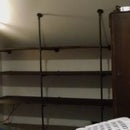Introduction: How I Installed Vinyl on My Buggy
it all started because riding without padding on the bars you rest your arm on was uncomfortable.
Step 1: First Decide What Color Vinyl, I Chose Red and Black Obviously.
now start measuring and planning. I used all measurements for the armrests and upper headrests ... also I installed zippers so that I can replace the foam if it goes bad It can easily be replaced
I sewed in a tunnel "in picture 2" to hold zip ties at each ends of the vinyl covers so when installed they hold tightly to the bars and help keep water from collecting inside
NOTE: I kept having feeding problems with the sewing machine. it kept hanging up I figured out that the problem was the vinyl was sticking to the metal foot and lower metal plate.
quick fix: wipe the vinyl with WD40 and that problem was solved
ANOTHER NOTE: wherever there's a folded piece you have to sew its best to iron it under wax paper. it helps keep the fold from slipping and it keeps you're lines straight. use a scrap piece to get the heat settings dialed in as well as the best technique to hold, fold and iron at the same time
I sewed in a tunnel "in picture 2" to hold zip ties at each ends of the vinyl covers so when installed they hold tightly to the bars and help keep water from collecting inside
NOTE: I kept having feeding problems with the sewing machine. it kept hanging up I figured out that the problem was the vinyl was sticking to the metal foot and lower metal plate.
quick fix: wipe the vinyl with WD40 and that problem was solved
ANOTHER NOTE: wherever there's a folded piece you have to sew its best to iron it under wax paper. it helps keep the fold from slipping and it keeps you're lines straight. use a scrap piece to get the heat settings dialed in as well as the best technique to hold, fold and iron at the same time
Step 2: The First Is Always the Worst But It Gets Better and Goes Faster I Promise
in the middle of sewing I had an idea that it would be cool to actually install headrests and my dad donated the 2 rear headrests in his van. his justifications were no one sits back in the 3rd row anyways so grab them!
NOTE: I had carefully taken the fabric off one of the headrests to get a pattern and ran into a problem the vinyl from the headrest had a foam backing. so the patterns I cut out were a little oversized because they didn't have foam backing so i needed to reinstall the old fabric so it wasn't loose and the new vinyl cover fit snugly on
NOTE: I had carefully taken the fabric off one of the headrests to get a pattern and ran into a problem the vinyl from the headrest had a foam backing. so the patterns I cut out were a little oversized because they didn't have foam backing so i needed to reinstall the old fabric so it wasn't loose and the new vinyl cover fit snugly on
Step 3: Tada
the foil thing is in a separate tutorial
Step 4: Seats
next was the disgustingly itchy burlap covered seats. this was installed by the previous owner. I liked the ratrod look but didn't like itchy fibers all over so it had to go
Step 5: Had Some Patchwork to Take Care Of
after taking the burlap off I found some cracks in the fiberglass so I patched them and braced any weak spots on the backside of the seats then prepped them for some 3M spray glue. then I sewed the vinyl
Step 6:
I didn't wait for the glue to get tacky first before I started molding the vinyl over the seat... this wasn't a problem it just took longer and a lot more rubbing and smoothing to get it to stick... first ones always the worst one!. eventually it stuck though
Step 7: Dash and Center Console
the dash was done like the seats and stuck on with 3M spray glue I then lined the edges with chrome car door trim.
the center console was installed with some closed cell foam and wrapped under 2 lengths of wood on each side and screwed in with boat screws with recessed washers
the center console was installed with some closed cell foam and wrapped under 2 lengths of wood on each side and screwed in with boat screws with recessed washers
Step 8:
this was my first time sewing vinyl and the first time I had sewn anything since I took a home economics class in middle school. laugh if you want! but because of that class I can make some bad A## banana bread!
Step 9: Buggy Fun
the whole family enjoys it
Step 10: Ready to Ride
including the road dog!





